Turning Left
Left turns are a necessary evil when driving a car.
They can seem dangerous.
They can seem complicated and nerve-wracking.
But, they don’t have to be.
There are ways to make sure your left turns are safe, too.
This article will dive deep into best practices, details, tidbits, practical, actionable steps you can take, and safety tips for how to turn left while driving at different kinds of intersections.
Who has the right of way when turning left on a solid green light?
Technically speaking, no one “has the right of way” until another road user has actually yielded. Thinking “I have the right of way,” is a great way to get into a collision. Having said that, if it’s just a regular ole green light intersection, then – roughly speaking here – pedestrians should be given the right to go first, then right-turning vehicles, and left-turning drivers must yield to everyone.
Enter Intersection on Green Only
When you turn left at a traffic light, you can enter the intersection only when the light is green.
Approaching The Intersection – Fresh Or Stale?
When approaching the intersection, consider whether the light is fresh or stale. If you know it is stale, be prepared to stop if the light goes to yellow.
Consider whether you’re past your point of no return. Knowing this may play a factor in how you decide to control (or are ready to control) your vehicle’s speed.
Check for Turning Restrictions
Make sure there are no turning restrictions. Are you allowed to turn left? If it’s not legal or not legal at that date/time then there’s no point in checking anything else, such as worrying about oncoming cars; since you can’t turn anyway.
Behold the no-left turn sign
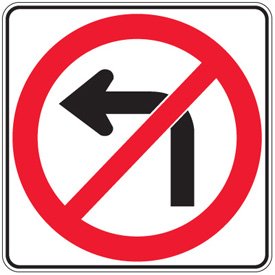
Where Are You Going?
The next thing to do is to check the area you are planning to turn into.
Make sure there is actually somewhere to go. This might sound obvious, but this is important. Simply find out where you are going, where exactly is the lane you’re going to end up in after your turn?
There may not be an available space due to:
• An Accident/Crash
• Construction
• Traffic Congestion
• Filming
• Another reason
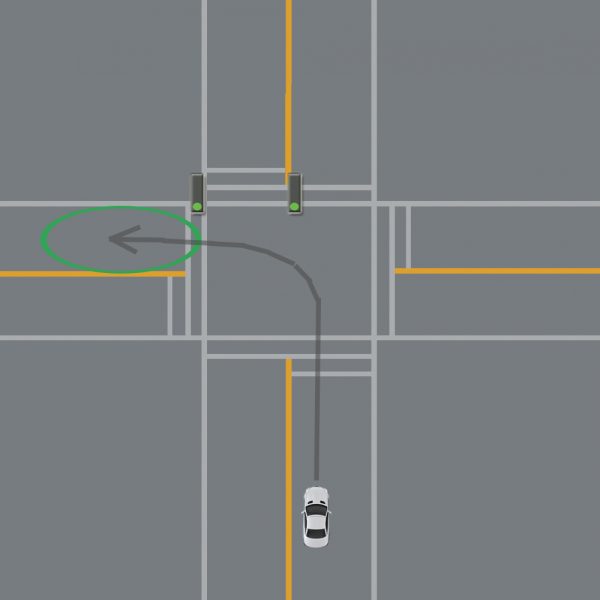
If there’s nowhere to go, then you can’t go there. Wow, that was profound. If there is no space, go to the next light and turn left.
Or, wait behind the white line for the traffic backup to clear if applicable (if the light turns yellow, you won’t be ‘trapped’ in an awkward position in the intersection or blocking pedestrians).
Remember you might also be able to ‘turn left’ by turning right three times instead.
Marine Drive and Heather Street
For example, you might think you’d like to turn left here. At first, it looks like a normal intersection. But if you check, you can see that you could turn right, but not left. (Marine Drive and Heather, Vancouver).

Complicated Intersections: Garden City Road in Richmond
Here’s another example. Granville and Garden City in Richmond. It’s not really a typical intersection. If you’re in the left turn lane it might not be immediately obvious where you are supposed to end up.

When You Are Stopped Waiting at the Traffic Light
If you’re stopped waiting at the red light in the left turn lane, it might be a good idea to check out where you’re supposed to end up turning. Especially if you are the first car at the light.
Just exactly where are you going to go?! Make sure you know the correct answer.
This is the same intersection here–>

Okay here’s one more. I already covered this but if you check here you’d find three “Do Not Enter” signs and two “Do Not Turn Left” signs.
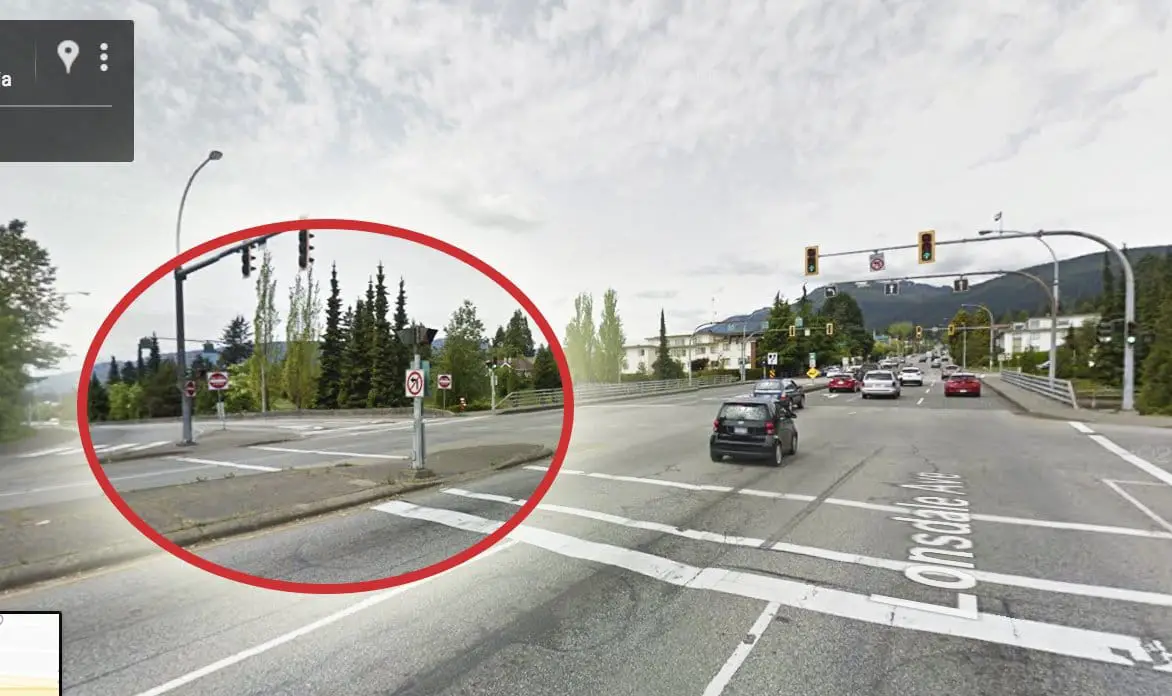
Check For People Walking & Pedestrians
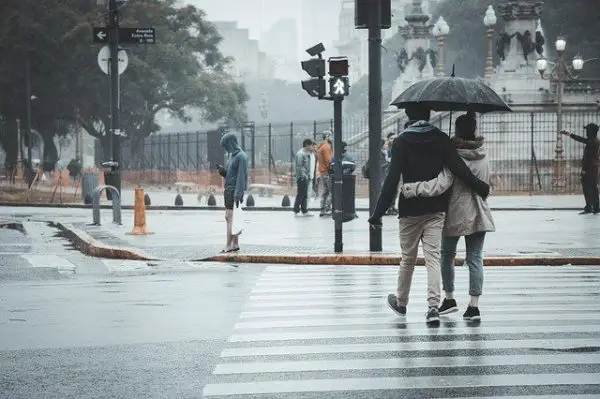
If there are people walking (or about to walk), move forward to around one-third of the way into the intersection.
Position the car so that you will have a short and easy turn into your lane without getting in the way of an opposing left-turning vehicle.
Wait until pedestrians are out of your way and almost on the opposite sidewalk. Keep your car and your tires straight in case you get rear-ended.
When the light changes
When the light turns yellow or red, exit the intersection when safe. If you enter an intersection when the light is green, you can leave the intersection legally when it is safe, regardless of the traffic light colour.
Say you waited behind the white line when the light is green, and it turns yellow or red, legally you must stay there, and you may be there all day.
When you’re unsure whether or not a person is going to walk, wait to see what they do. This is safer than turning and finding out they are walking, then having to stop at a difficult or awkward angle on the wrong side of the road.
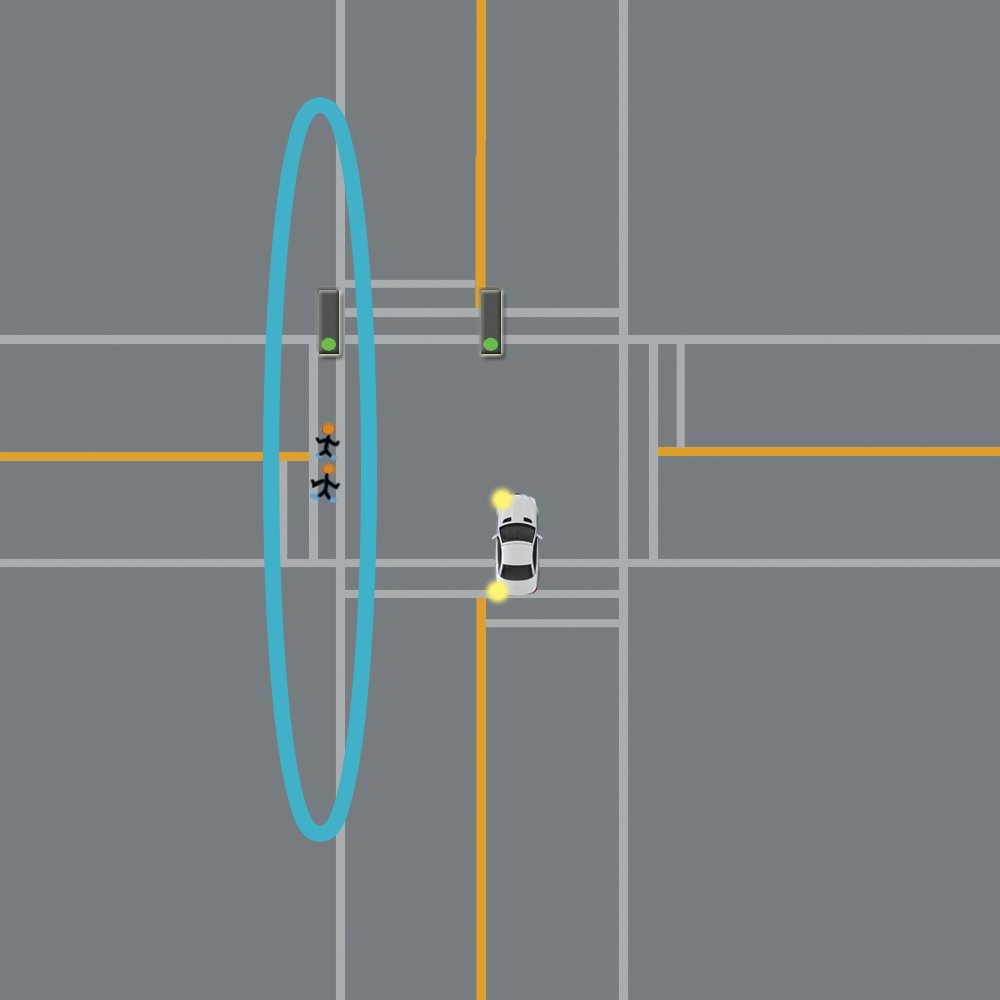
Check Out Oncoming Traffic
Yield to any oncoming and conflicting traffic. Left turns have zero right of way in this situation.
No one should have to stop and wait for you when you are turning left. Left turns yield to right turns especially if there is one lane.
If there is more than one lane, stagger it to be safe. In other words, time it so that when you are turning there is space beside you rather than the right-turning car.
Follow a few seconds after the right-turning car or, if the right- turning car is very slow and far away, and if it’s safe and there are no pedestrians then go before it.
Read more about space management in driving.
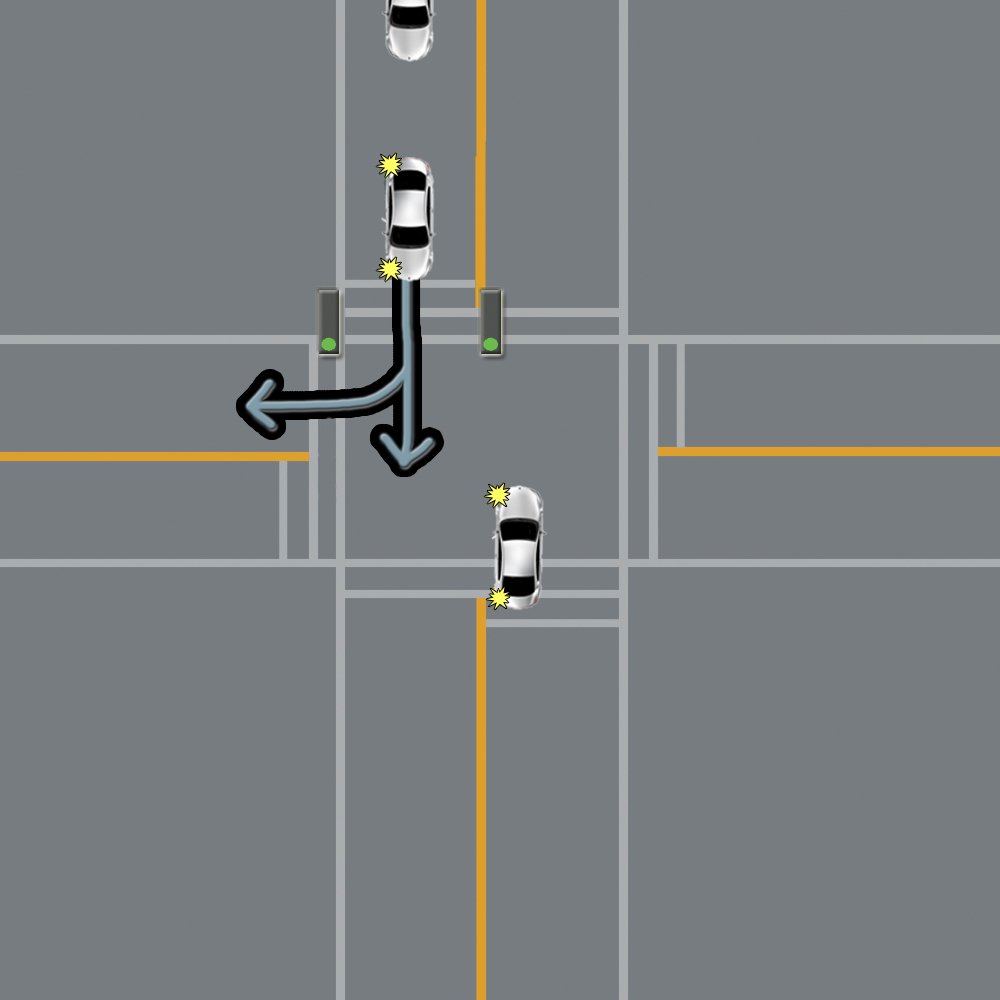
Keep An Eye On The Traffic Light
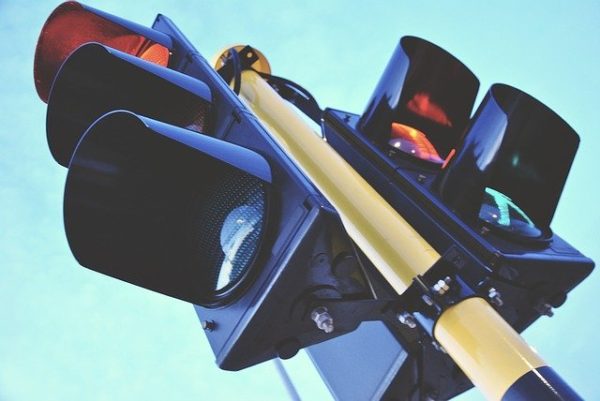
Keep an eye on the traffic light. Note especially the traffic light on the left side of the intersection since it’s in the general direction you should be looking.
Leave the intersection only when you are 138% sure it is safe. Turning left is considered generally complex and dangerous since you are turning across the lanes of the oncoming traffic.
This light is also lower than the regular one, and can help so much on a sunny day, when you have your sun visor thingy down blocking the regular normal traffic light.
This left light is your friend.
You definitely have to do some multitasking when you’re turning left.
New drivers often pay attention to the oncoming traffic without noticing their light has changed, sometimes leaving them hanging out in the intersection longer than necessary.
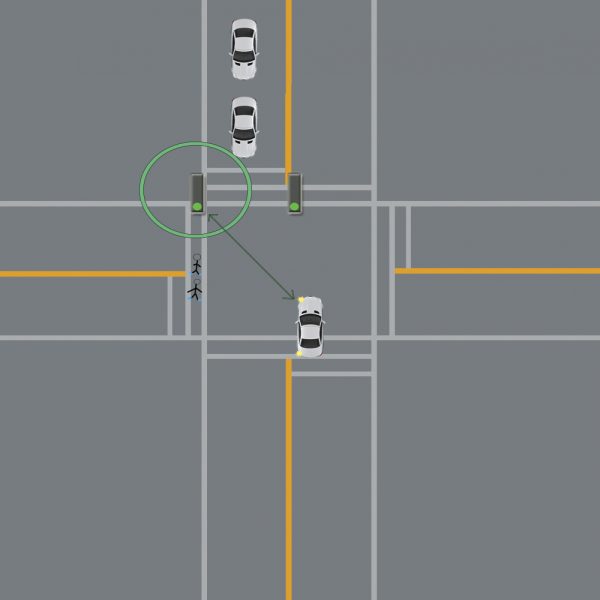
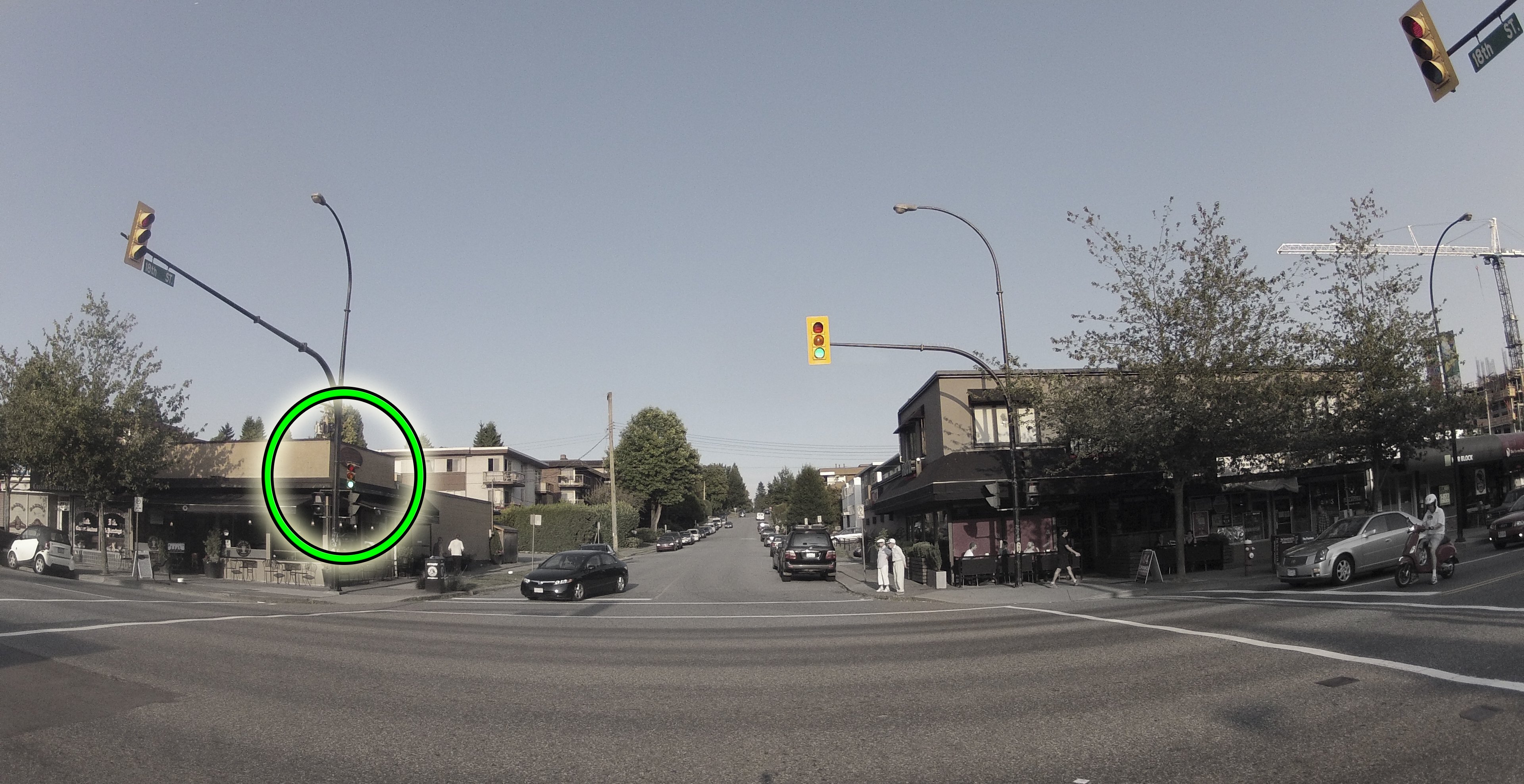
When The Vehicle in Front of You is Also Turning Left
If there is a car in front of you turning left, wait behind the white line in case the light turns yellow. When the vehicle turns, and the light is still green, treat it as you would any other green light.
When the intersection is very wide/large and you can fit most (at least three-quarters) of your car in front of the crosswalk, then you may pull forward behind another vehicle.
Legally, you are considered to be in the intersection. If the light changes to yellow, leave when safe (as above).
Keep in mind you don’t have to enter the intersection if you don’t want to when there is another vehicle in front of you. This is difficult to make suggestions about because it depends a lot on the size of the intersections and vehicles, and other circumstances, so use your best judgment.

When The Oncoming Vehicle Also is Turning Left
If there is a left-turning car facing you and your visibility is diminished, or anytime you aren’t 100% sure it is safe, then wait patiently and keep your car straight.
Drivers are allowed to pass around to the right of a left-turning vehicle and continue straight through the intersection. The longest you would wait is the time it takes for the light to turn yellow or red.
When the light goes yellow, wait for any cars that may be racing through – or casually meandering as the case may be – then leave quickly when safe to do so.
Never turn unless you know it is safe and are sure that oncoming vehicles are planning to stop. There is no need to watch them stop completely but you must be sure they intend to.
If other drivers behind you honk, ignore them. The safety decision is yours, not theirs. The consequences will be yours, not theirs.
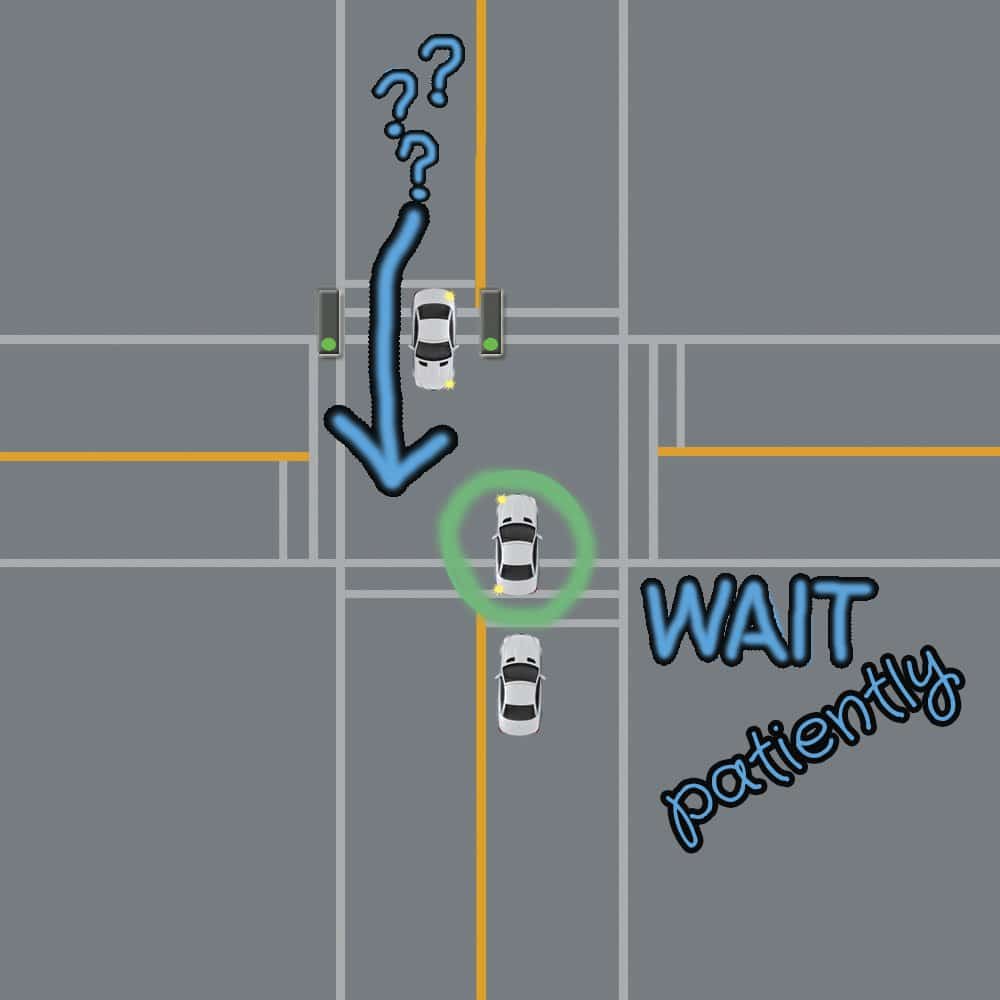
Can You Turn at The Same Time?
When a left-turning car is facing you, and there is no oncoming traffic (and you can clearly see that there is no oncoming traffic) nor any pedestrians in the crosswalk, you should have lots of room to safely turn at the same time.
Make sure that the other car is showing a left-turn signal and that the driver is actually going to turn left. Drivers sometimes have their turn signals on but then go straight, and this is a very good way to have a crash.
Judge the car—is it slowing down? Can you make eye contact with the driver?
Not that eye contact would help too much, but you can often tell a lot about the intended plan for the vehicle by looking at the driver. Wait until it’s clearly obvious the car is planning to turn left—then proceed.
Also, you do not “have to’“go at the same time.
If you’d really like to play it super duper extra extra extra safe, wait for the other car to go and then go after it. That is perfectly fine.
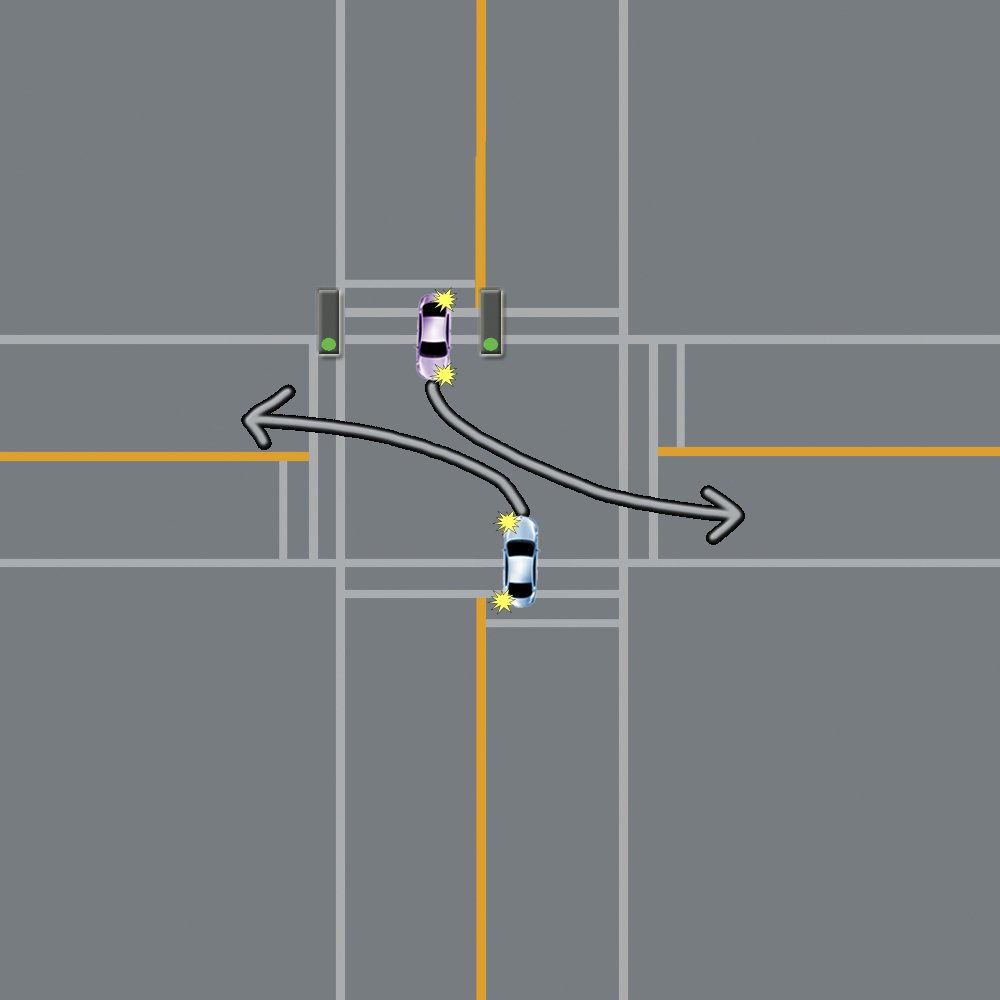
Make sure the vehicle is actually going to turn right before you move. Even then, you can not trust that they’ll go into the lane they are supposed to. It’s not wise to turn at the same time.
Sometimes It’s Too Easy
If there’s a space to move into… no pedestrians… no oncoming cars… and a green light…
…slow to 20 km/h, quickly scan the intersection from left to right, then turn and look where you’re going. You don’t have to stop first — Please don’t.

Turning Arrows
Flashing or not flashing green arrows (left-turn arrow)
Everyone else, including pedestrians, has a red light. If pedestrians walk while you have the flashing arrow, honk your horn and ask them to move out of the way quickly.
When the light turns yellow, treat it like the point of no return, just as you would if you were going straight.
Say the arrow disappears and you still have a green light, move forward into the intersection, just as you would at any other green light that never had the arrow.
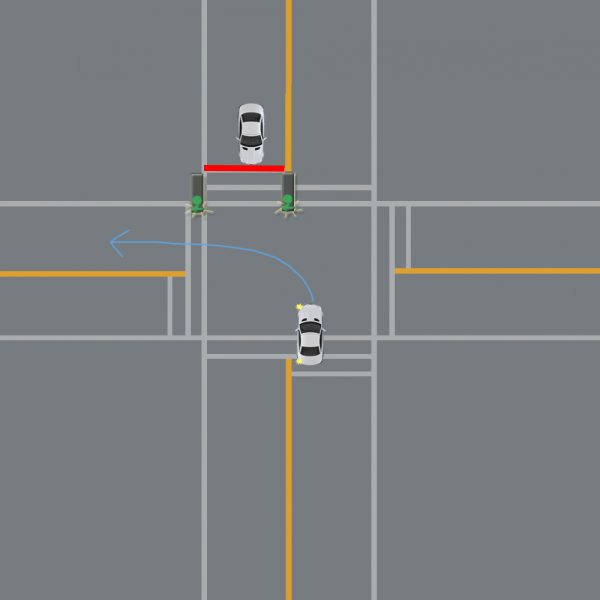
You can still turn left just like your normally would, even after the arrow has gone. Just treat it like you would any other left turn.
You would only stop and stay stopped behind the line if you had a good reason to do this, such as a red light, or traffic congestion.
Left-Turn Signal Lights
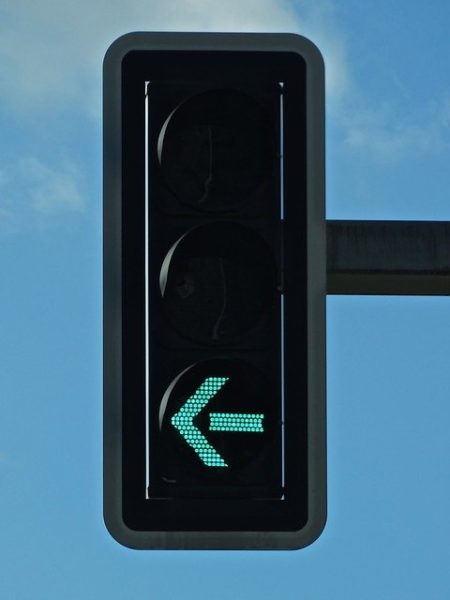
Stop behind the line and when the light turns red wait for the next green arrow. Turn left when the light changes to green.
All other conflicting traffic and pedestrians will be facing a red light.
The Point of No Return & Yellow Lights
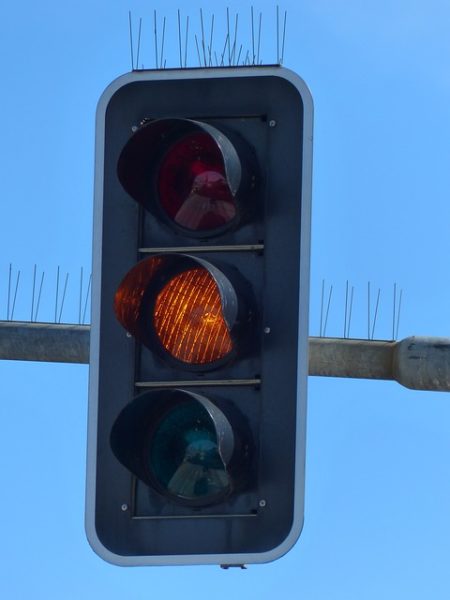
The idea of the point of no return is the same as going straight. If the light turns yellow and you can still safely stop behind the white line, then do so.
Otherwise, if you are past the point you can safely stop, simply complete your left turn quickly as soon as it is safe (as above).
Leaving The Intersection When the Light Goes Yellow (And Then Red As They Do)
Of course, it is fine to wait until you are 120% sure it’s safe to leave the intersection, before turning left – even if that means waiting until the light has gone red before you leave (if you’ve already entered the intersection).
However, as soon as you are sure it’s safe to turn (and this is a judgment thing, which you can get good at by practicing a lot.)
Then you must leave the intersection quickly. Do not hang out in the middle of the intersection.
Some new drivers don’t get the greatest education and are told not to leave until safe, they end up on the extreme opposite where they are stopped in the middle of the intersection long after it’s been safe to leave, and this isn’t good either.
Hand Signal For Left Turn
Do you know what to do if your signal light burns out? You can check this article out for a reminder how to do your proper hand signals when driving.
Can You Turn Left on a Red Light at an Intersection?
You can not turn left on a red light if you’re turning onto a two-way street (it’s illegal).
You may turn left on a red light from a one-way street onto another one-way street or from a two-way street onto a one-way street. Treat as you would a right turn on a red light. You must completely stop and yield to others before proceeding. Of course, check for turning restriction signs.
So check with your local laws, as this info is relevant to beautiful British Columbia. And always remember, you never have to turn on a red light.
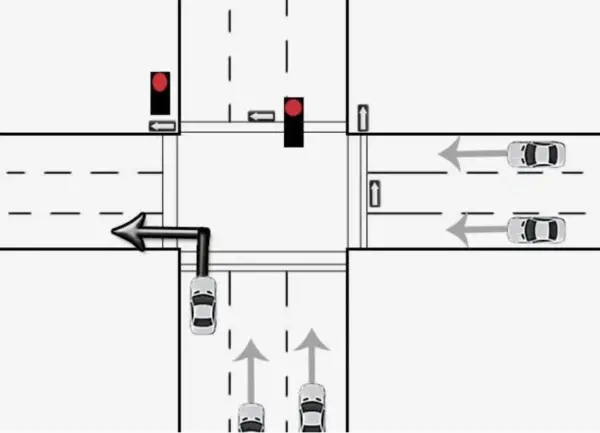
Can You Turn Left On a Green Light Without an Arrow?
Some intersections have left-turning arrows that don’t last as long as the green light. Yes, you can turn left on a green light without an arrow, as long as you’re still facing a green light and not some kind of a red one.
Left Turn Arrow & Right Lane
Here’s a question about the left turn arrow & right lane right-of-way. This can be confusing for many new drivers.
Driver Questions
Question: I am turning left on a left-turn green arrow. It has a green light on to a two lane street. I want to immediately be in the right lane because I want to turn right at the next block. I have my right turn indicator on.
A vehicle from the opposite direction is turning right on a red light with a ‘yield to right of way’ triangle sign. There is not a merge lane for the right turning vehicle. Is the right turning vehicle supposed to wait for the green light? And if not, who has the right of way for the right lane?
It’s a good question
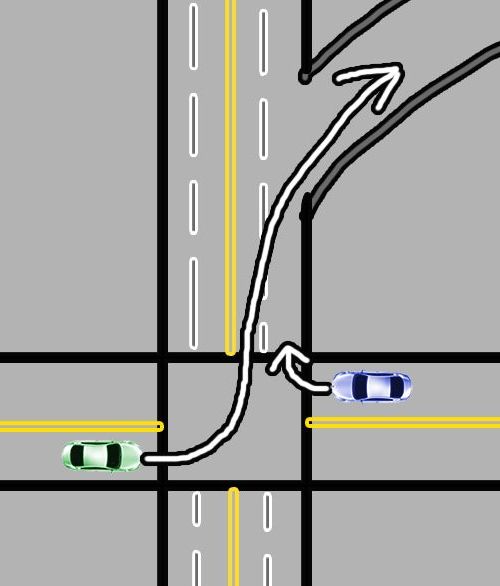
Which intersection is this? Is he facing a red light, or a yield sign? (Usually it is one or the other) In any case, that car (turning right) is required to yield to any traffic and not go to until safe.
The motor vehicle act never says that the left lane belongs to the left turning car, and the right lane belongs to the right turning car. It says cars facing red lights and yield signs are required to yield to any traffic on the road and not to go until it is safe.
While you do not want to turn directly into the right lane (you’re supposed to initially turn into the left lane), if you start your left turn and then switch to the right turn signal and plan a lane change immediately after the intersection, this is a legal lane change. However, can you trust the other car? No probably not right?
Some drivers seem to think that the left turning car has to want to stay in the left lane, allowing them to turn right at the exact same time. This is dangerous in general not to stagger a turn (where is your escape route?) and to expect to be able to turn right on a red light at the same time as a vehicle lawfully going through the intersection on a green arrow. Not to mention this is just not reality. If the left turning car wanted to stay in the left lane and turn left over and over again he’d be driving in circles (squares, technically.)
Obviously to be defensive and avoid crashing into them, though, you may have to put up with them and be careful – honk and tell them to stay put if you think that will work – and if they turn, may have to slow down in order to get to the right lane to be able to do your right turn…in other words use caution. I am not sure if you would be found partially at fault in the case of a collision because technically you would have done an “unsafe lane change” … and they would have done an unsafe turn against a red signal / yield.
Right Turn
(3) Despite subsection (1), and except when a right turn permitted by this subsection is prohibited by a sign at an intersection, the driver of a vehicle facing the red light, and which in obedience to it is stopped as closely as practicable to a marked crosswalk on the near side of the intersection, or if there is no marked crosswalk, as closely as practicable to the intersection, may cause the vehicle to make a right turn, but the driver must yield the right of way to all pedestrians and vehicles lawfully proceeding as directed by the signal at the intersection.
Left Turn
(3) When the driver of a vehicle intends to turn the vehicle left at an intersection where traffic is restricted to one direction on one or more of the highways, the driver must cause the vehicle to approach the intersection in the extreme left hand lane available to traffic moving in the direction of travel of the vehicle, and after entering the intersection turn the vehicle to the left so as to leave the intersection as nearly as practicable in the left hand lane available to traffic moving in the direction of travel of the vehicle on the highway being entered.
Yield signs
(2) Except as provided in section 175, if 2 vehicles approach or enter an intersection from different highways at approximately the same time and there is a yield sign, the driver of a vehicle facing the sign must yield the right of way to all other traffic.
Arrows
130 (1) When a green arrow is exhibited at an intersection by a traffic control signal,
(a) the driver of a vehicle facing the green arrow may cause it to enter the intersection and to make only the movement indicated by the green arrow, but must yield the right of way to pedestrians lawfully in the intersection or in an adjacent crosswalk and to other vehicles lawfully in the intersection,
I hope that answers your question. To answer it more directly who has the rights to the right lane? Well, both cars have a duty to not enter that lane unless it is safe. So, no one really has the right to it I guess is the answer. It is a common and tricky situation, because more often than not that right turning car wants to then get into the left lane and turn left.
In my personal opinion the right turning car should sit there and wait until there are no more cars turning left facing the left turning arrow and it is otherwise safe and clear. But that’s just my opinion. Isn’t this the whole point of having a left turning arrow? So that you may enjoy this rare opportunity to turn left without having to worry about oncoming traffic?!?! Just my 0.02
Question Time!
Question: Is it legal to make a left turn, when clear, if it says
‘Turning vehicles delayed arrow’?
‘Left Turns Delayed’
I’m not sure how to answer this other than to say this is merely a friendly yellow sign that offers you some additional information, basically to keep your impatience in check in my opinion, Whether it is legal, depends not on that sign, but on the traffic control devices at the intersection, as per usual.
Road Signs – Colours
Recap: the road sign colours mean something. White signs are regulation signs; Yellow signs are warning/’hazard’ signs.
In other words, simply do whatever you would do if that sign weren’t there. That sign doesn’t tell you if you can go or not go, it merely states that there will be a delayed arrow/light as oppose to the advanced one that you might be more accustomed to.
Follow the usual rules for left turns while facing green lights, red lights, etc. For example, you can legally turn left if you are facing a regular green light and it is safe and clear; if there’s nothing telling you to stay stopped, then you don’t have to. But if you are faced with a red light – or red arrow – then it’s illegal to turn left onto any 2-way street, even if there are no oncoming vehicles.
Hope that makes sense.
King Edward & Lougheed
Safe Driving Habits: Keeping Tires Straight
If you’re wondering if you need to keep your tires straight while turning left, keep reading. The answer is, YES, Please do.
If you’re rear-ended while waiting, and your tires and vehicle are straight, then your vehicle will be pushed straight ahead. This would be bad, but not the end of the world.
If your vehicle and/or tires are turned, you may be pushed into oncoming traffic in the case of a rear-end collision, and may be then T-boned. This is way worse than simply being rear-ended once.
Yielding To Oncoming Road Users On A Left Turn
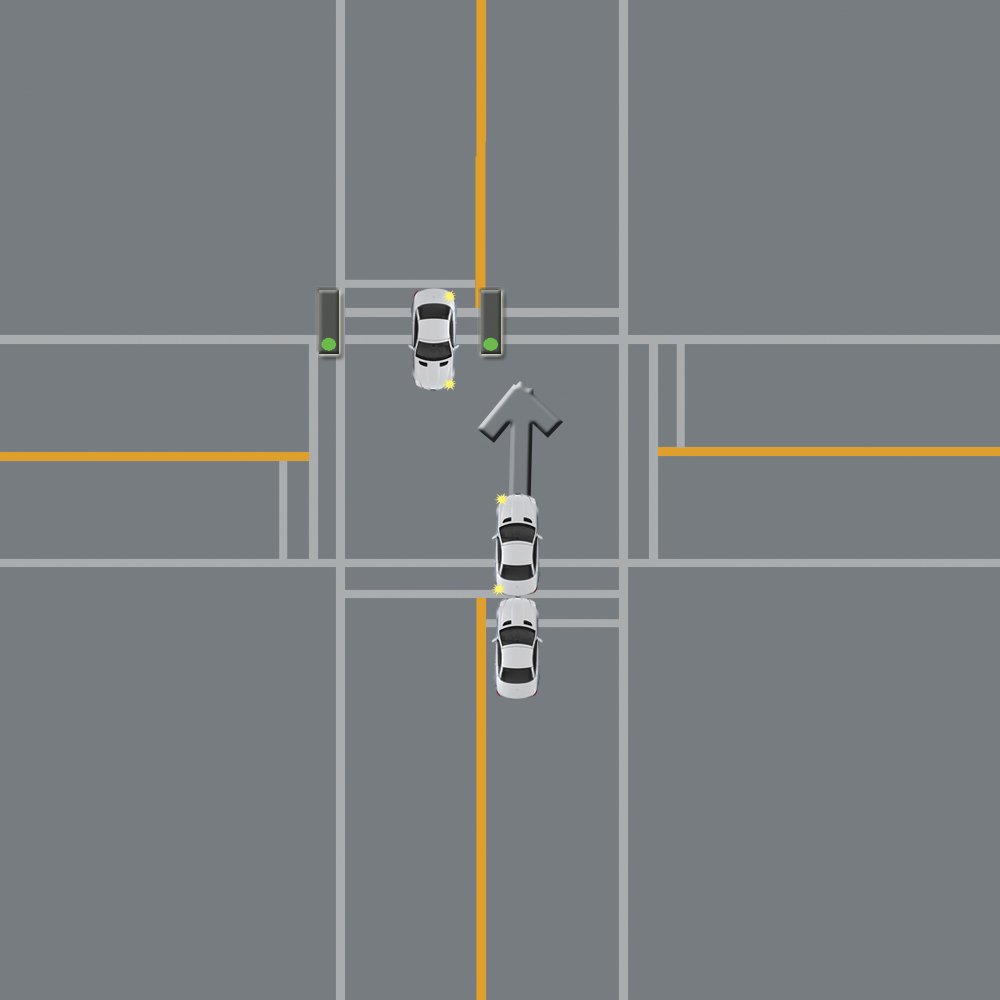
Keeping A Straight Position Protects You From Secondary Collisions
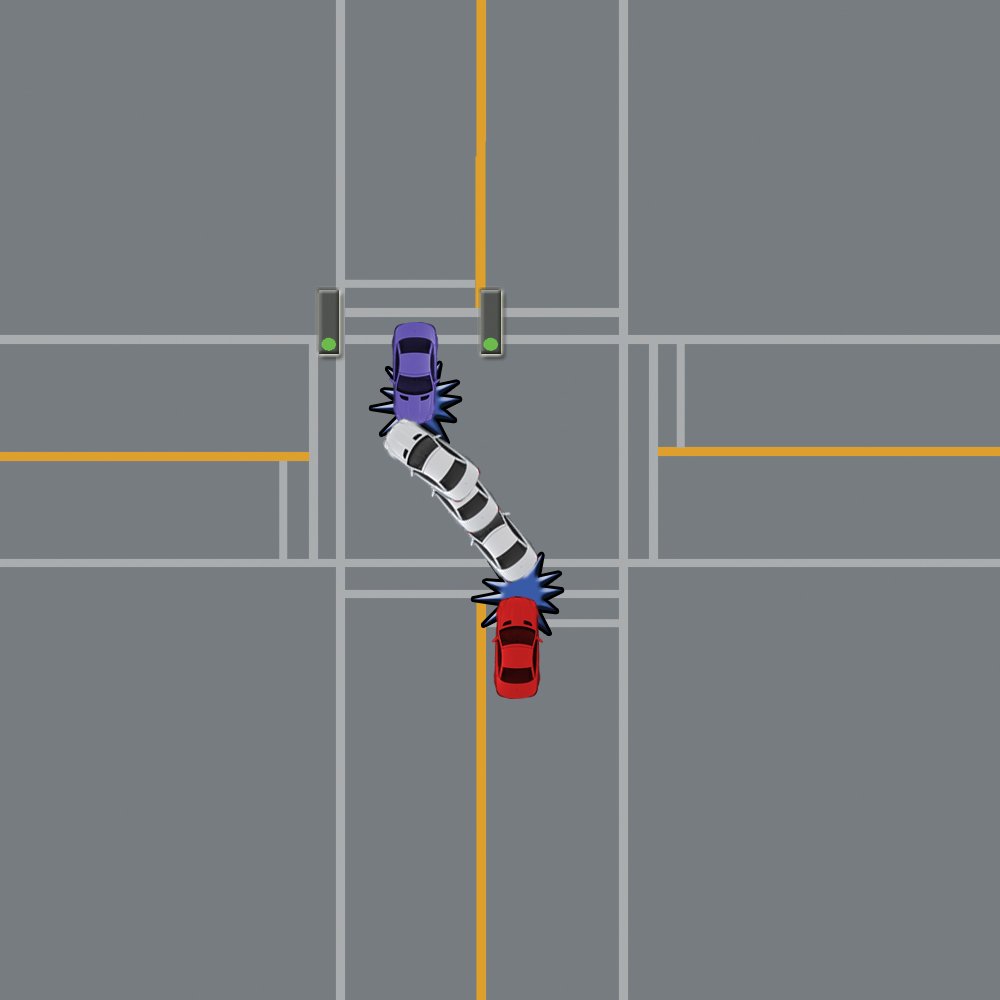
There are some exceptions, like this intersection on Cambie St. in Vancouver. Here, you kind of have to angle your vehicle as per the little white guidelines. So here is one example where your tires and vehicle won’t be ‘straight’ and that’s okay.

Often, if your vehicle is completely straight like it should be, it means you can’t properly see oncoming traffic. In this case, simply wait until the signal goes yellow or red – whenever it is safe, turn. If you don’t know, or aren’t sure, or can’t see if it’s safe, then wait.
Conclusion
Turning left isn’t always fun, but if you must know how to do this, may as well do it safely. With enough practice you will get more confident with them and it will be just another driving skill.
However if you do this wrong, it can be very dangerous. Don’t take chances with your left turns. Err on the side of caution. And remember, the longest you will wait is for the light to change. You won’t be there all day, so just be patient. Time to read about turning right at a traffic light? Preparing for your ICBC road test? Be sure to check out my epic article: ICBC Road Test Tips For Classes 5 & 7 [Instructor Gets Deep].
Carmen Cohoe
Carmen became a driving instructor in beautiful North Vancouver at the age of 22 due to some crazy people who agreed to hire her. After that, there was never a dull moment teaching many different folks from many different places how to drive using automatic and standard vehicles and a minivan.

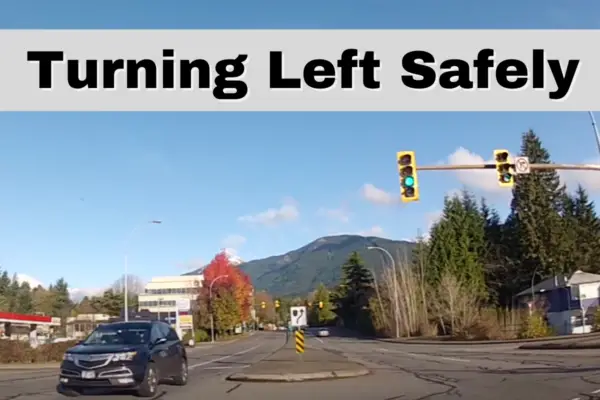
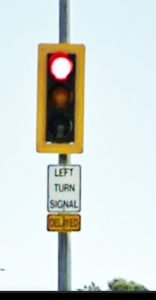
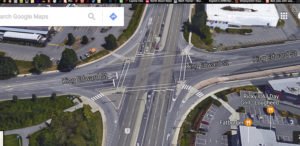

In turning left onto a 2 lane road with an oncoming car in a right hand turn lane for the same 2 lane road, is the oncoming right hand turning car required to turn into the first lane leaving the second lane open for my left turn access?
I am in fact thankful to the owner of this web site who has shared this great article at at this time.
If you come to a left turn arrow at an intersection and after the intersection there is another left turn arrow. Can you stay in the left turn arrow lane, then cross the intersection then make your left turn?.
Hi, I’m not sure what you mean. Can you give me the intersection name? You are not allowed to go straight while you are in a left-turn only lane, if that’s what you mean. If you are in a left-turn-only lane then you must turn left. But if you’re in a lane that could go left or straight, then you can go to the 2nd intersection and then turn left. If that’s what you mean! Let me know. :)
Hi Carmen,
First of all thanks for sharing all this information, I wish I found this before I failed my road test today.
But I believe as a long time driver in another country with new traffic rules for intersections, I did know the rule but the traffic condition made me to make a decision and I chose to play safe and the examiner told me that I didn’t know how to make left turns and therefore unqualified. In two cases where I turned left there was obstacles caused by other drivers and their vehicles and the instructor come to a conclusion without considering this.
In my first left turn in the back streets of downtown Courtenay, one car has been stopping way past the stop sign almost in the middle of the oncoming traffic lane on my left. So I stopped thinking that it can be hazardous for that vehicle who was on the left street I was turning onto but the hood of his car was out on the road and there was another car coming from the oncoming traffic who last minute turned the right signal to turn onto where I was going. It was an awkward position but as a driver I belive that I made the safest move cuz I had to make sure that car was not going to move who was supposed to be way behind the stop sign and there was another car coming who had the right of the way.
In the second turn we were on Cliffe Ave. just to pull in the Service BC’s parking lot where I was going to stall park and finish the road test with a pass. So there are traffic lights in this intersection and a turning lane, it is a pretty busy road. I was the first car in the left turn lane and the light was green for a while while I was approaching so I slowed down and came to a full stop as the oncoming traffic was constant and there was no safe gap, I stopped just before the white line in the turning lane to have more visibility as there was a big truck waiting to turn left right across me on the left turn lane of the oncoming traffic. Meanwhile the light turn to red so I had to wait the next green so I could turn. If that truck was not there I would have gone a bit further pass the white line and could have turned when the light change but the instructor insisted that I should have waited pass the white line. In this two cases road conditions has affected the situation but the decision was given regardless of them.
I was really disappointed with this outcome and decision of the examiner.
Hi again Carmen,
I took my road test again and I passed this time!!! YAY!
Nice, Congratulations!! Enjoy
Is there a diagram posted anywhere explaining where you are allowed to/supposed to shift a manual car when turning left in an intersection?
Thank you!
It would be kind of the same as if you were just driving straight, depending on your speed.
You are allowed to change gears inside an intersection, there’s no law against it.
can I make a left turn from The Mcdonald parking lot to SW marine Dr. close to The Vancouver Honda?